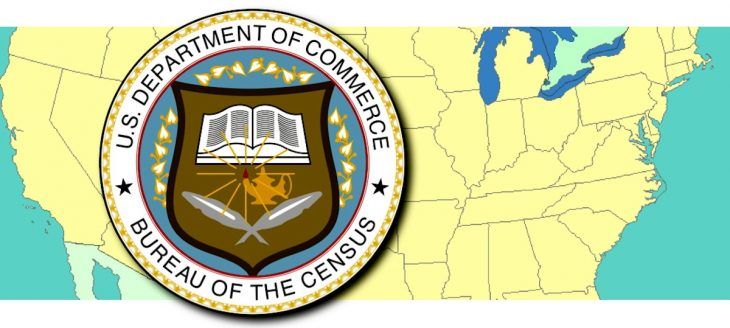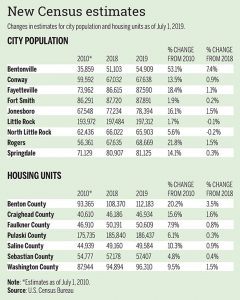Bentonville ranked 5th fastest-growing U.S. city; Northwest Arkansas cities lead growth in state
by May 21, 2020 8:49 am 14,086 views

Bentonville added more than 10 people per day between 2018 and 2019 and was the fifth fastest-growing U.S. city with at least 50,000 people, according to the U.S. Census Bureau. Northwest Arkansas cities continued to lead the growth in the state.
The Census Bureau released Thursday (May 21) estimates as of July 1, 2019, for U.S. city population and housing units by county. The July 2019 estimate is the last before the official 2020 Census results are announced.
Between July 1, 2010, and July 1, 2019, the population of Bentonville rose 53.1%, or by 19,050 people, to an estimate of 54,909. Between 2018 and 2019, the population increased by 7.4%, or by 3,806 people.
“Bentonville’s growth has been pretty steady from 2011 onward,” said Diego Caraballo, a demographer for the Arkansas Economic Development Institute at the University of Arkansas at Little Rock.
Among cities with at least 50,000 people, Rogers was the second-fastest growing city in the state between July 1, 2010, and July 1, 2019. Its population increased 21.8%, or by 12,308 people, to 68,669. Between 2018 and 2019, the population rose 1.5%, or by 1,034 people.
Fayetteville had the third-fastest growth in the state between 2010 and 2019. Its population increased 18.4%, or by 13,628 people, to 87,590. Between 2018 and 2019, the population increased by 1.1%, or by 975 people.
In northeast Arkansas, Jonesboro was the fourth-fastest growing city in the state between 2010 and 2019. Its population increased 16.1%, or by 10,846 people, to 78,394. Between 2018 and 2019, the population rose 1.5%, or by 1,160 people.
In six years over the past decade, the city’s population has risen between 1-2% per year, Caraballo said, adding “that’s pretty steady, so I would imagine that it would be something like industry attracting people along with just your normal natural growth.”
Springdale was the state’s fifth-fastest growing city between 2010 and 2019. Its population increased by 14.1%, or by 9,996 people, to 81,125. Between 2018 and 2019, the population rose 0.3%, or by 218 people.
Over the past decade, Springdale’s growth has slowed after experiencing its largest period of growth of nearly 2% between 2012 and 2013. Since then, the growth has consistently slowed, Caraballo said, adding that the biggest decrease in the growth was between 2018 and 2019.
In central Arkansas, Conway was the sixth-fastest growing city between 2010 and 2019. Its population increased 13.5%, or by 8,046 people, to 67,638. Between 2018 and 2019, the population increased by 0.9%, or by 606 people.
The population of North Little Rock increased 5.6%, or by 3,467 people, to 65,903, between 2010 and 2019. The population declined by 0.2%, or by 119 people, from 2018 to 2019.
The population of Little Rock rose 1.7%, or by 3,340 people, between 2010 and 2019. Its population fell 0.1%, or by 172 people from 2018 to 2019.
Caraballo noted the continuing trend of people moving from the cities and into the surrounding areas and possibly Conway.
 Between 2015 and 2018, Conway’s population growth accelerated, and over the same period, North Little Rock’s population declined, he said. The population change between the two cities doesn’t match, however, and he explained this shows that not everyone who’s leaving the city is moving to Conway.
Between 2015 and 2018, Conway’s population growth accelerated, and over the same period, North Little Rock’s population declined, he said. The population change between the two cities doesn’t match, however, and he explained this shows that not everyone who’s leaving the city is moving to Conway.
The population of Fort Smith increased by 1.9%, or by 1,600 people, to 87,891 between 2010 and 2019. Its population rose by 0.2%, or by 171 people, from 2018 to 2019.
If the existing growth of Fort Smith and Fayetteville were to continue, Caraballo expects Fayetteville’s population to exceed Fort Smith’s population in the 2020 Census. With redistricting data expected to be released by July 31, 2021, Caraballo said city and county population data from the 2020 Census should be released by then. However, he was uncertain when the Census data for metro areas will be released.
“Unless the Census Bureau changes anything, they should not be releasing 2020 population and housing estimates before the 2020 Census data release,” he said. “This is because the data releases they do for the Census years use that data for the calculations.”
So far, Arkansas is ranked 38th in the United States for its 54.5% response rate to the 2020 Census. The COVID-19 pandemic has led to the extension of the deadline to respond to the Census to Oct. 31, from July. The response rate is higher at this point compared to the 2010 Census when the responses couldn’t be completed online or over the phone.
Arkansas’ population as of July 1, 2019, was estimated to be 3.01 million. That’s up 3.4% from 2.91 million on July 1, 2010.
Between April 1, 2010, and July 1, 2019, Frisco, Texas, was the fastest growing city with at least 50,000 people. Its population rose 71.1% to 200,490. Between 2018 and 2019, Leander, Texas, was the fastest growing city with at least 50,000 people. Its population rose 12% to 62,608.
HOUSING UNITS
Between July 1, 2010, and July 1, 2019, the number of households in Arkansas rose by nearly 71,000, Caraballo said. Over the period, the five counties with the highest growth rate for housing units were Benton, Craighead, Saline, Washington and Faulkner counties.
He noted the counties with the largest amount of household growth have also experienced population increases.
“It doesn’t look like they’re necessarily building more housing than would be required,” Caraballo said.
The number of homes in Benton County rose 20.2%, or by 18,818 homes, to 112,183, between 2010 and 2019. The number increased by 3.5%, or by 3,813 homes, from 2018 to 2019.
Over the past decade, the home growth rate in Benton County has risen, with the highest rate coming between 2018 and 2019, he said.
Between 2010 and 2019, the number of homes in Craighead County increased 15.6%, or by 6,324 homes, to 46,186. The number rose 1.6%, or by 748 homes, from 2018 to 2019.
Between 2010 and 2019, the number of homes in Saline County rose 10.3%, or by 4,645 homes, to 49,584. The number rose 0.9%, or by 424 homes, from 2018 to 2019.
Between 2010 and 2019, the number of homes in Washington County rose 9.5%, or by 8,366 homes, to 96,310. The number increased by 1.5%, or by 1,416 homes, from 2018 to 2019.
Between 2010 and 2019, the number of homes in Faulkner County increased 7.9%, or by 3,699 homes, to 50,609. The number rose by 0.8%, or by 418, from 2018 to 2019.
The number of homes in Pulaski County rose 6.1%, or by 10,702 homes, to 186,437 from 2010 to 2019. The number increased by 0.3%, or by 597 homes, from 2018 to 2019.
The number of homes in Sebastian County increased by 4.8%, or by 2,630 homes, to 57,407 from 2010 to 2019. The number rose 0.4%, or by 229 homes, from 2018 to 2019.
